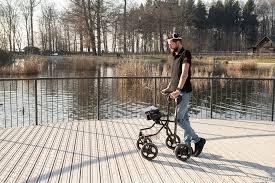
A team of Swiss neuroscientists have given a paralysed man the ability to walk again thanks to electronic brain implants, that use wireless signals to reconnect the brain with the spinal chord, through restored communication.
Gert-Jan Oskam was told he would never walk again after breaking his neck in a traffic accident in China 12 years ago, but since receiving the delicate “digital bridge” surgery in July 2021 he has been able to climb stairs and walk smoothly for more than 100 metres, albeit at a very gentle pace, simply by using his own thought processes.
The scientists have a long-standing programme to develop brain-machine interfaces which they envisage will eventually be able to assist people in overcoming paralysis, but they stress that the system is still at a basic research stage and therefore is many years away from being available to all paralysed patients.
Signalling a change for the better
The implants send signals to the muscles that are needed to flex the hip, knee, and ankle joints and have allowed Mr Oskam, a 40 year-old Dutchman, to have movement that he believed had left him for ever. “I can stand up and have a beer with my friend which is a pleasure that many people do not appreciate. Now I can just do what I want, when I decide to make a step the stimulation will kick in as soon as I think about it,” he said enthusiastically.
Delicate operation
Professor Jocelyne Bloch, a neurosurgeon at Lausanne University, who undertook the intricate procedure, explained how she cut two circular holes on each side of Mr Oskam’s skull which were approximately 5cm in diameter, immediately above the parts of the brain that control movement. This was followed by the insertion of two disc-shaped implants which wirelessly transmitted brain signals to two sensors attached to a helmet on his head.
An algorithm was then developed by the team which translated those signals into instructions to leg and foot movement, via a second implant inserted around his spinal cord, which Professor Bloch had expertly attached to the nerve endings, that are related to the ability to walk.
Finally, electrodes were installed onto Mr Oskam’s brain which detect neural activity whenever he tries to move his legs. The readings it produces are turned into pulses, which are sent to further electrodes in his spine to activate nerves and in turn, switch on muscles to produce the intended movement.
Hope for spinal injury patients
Recognising the value of their work, Professor Bloch said: “The important thing for us is not just to have a scientific trial, but eventually to give more access to more people with spinal cord injuries who are used to hearing from doctors that they have to get used to the fact that they will never move again.” It brings hope where previously there was none.
Greater control
These brain implants crucially build on the earlier work of Professor Grégoire Courtine of the École Polytechnique Fédérale in Lausanne (EPFL), which used a spinal implant to restore movement. Mr Oskam had the spinal implant before he had the brain implants and made the observation: “I felt before that the system was controlling me, but now I am controlling it”
Huge potential
Professor Courtine was keen to look to the future with enormous optimism. “Gert-Jan received the implant 10 years after his accident; but imagine when we apply our brain-spine interface a few weeks after an injury, the potential for recovery is tremendous.”













0 Comments